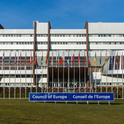The other day I went to Spain for lunch. I flew to Barcelona, caught a bus into town, and booked into a hostel. The next morning, dressed in a three-piece suit, I hired a car and drove north. The weather was cloudy when I set off, and it began to rain. However, arriving at a town called Roses, not far from the French border, the skies brightened and the sun began to edge through the clouds.
I left Roses via a winding road and made my way along a stretch of unspoiled coastline. Sheep crossed the road ahead, their bells jangling. Glancing in my rear-view mirror, I saw a red Ferrari, a couple of bends of the road behind me, but approaching fast. Soon we arrived at a cove and the sun freed itself completely, flooding the landscape in dazzling light.
I passed through gates bearing the restaurant's name, and followed a driveway to a sprawling bungalow. The Ferrari parked a few cars down from me on the gravelled forecourt; a respectable, middle-aged couple got out, and headed for a palm-lined garden. I made my way inside, where the maitre d'-a tall, earnest-looking man with a slight stoop-introduced himself. "We've prepared a special menu for you," he said. "But first come and meet the chef."
We emerged into a large, whitewashed space, more laboratory than kitchen. As many as 30 chefs scurried around high-tech stoves and marble-topped workstations; light cascaded in through the windows, giving their movements a floating, balletic appearance. The head chef presided, his name emblazoned on his jacket. We shook hands and, for a moment, I felt sharp eyes upon me. "You can talk later," the maitre d' said, before leading me to a table in the corner of a homely dining room, where I sipped a citrus cocktail and leafed through a long wine list.
In London, two years before, I went to see a chef about a job and he told me of a maniacal Spaniard whose menus were as long as his dishes were complicated. "He's mad, but a genius," the chef said. I later discovered that the Spaniard was called Ferran Adrià and that his Michelin three-starred restaurant, the oddly-named El Bulli (bulli is Spanish for bulldog), was in a remote bay on the Costa Brava.
I had tried to book, only to be told there were no tables for months. Not to be discouraged, I sent an e-mail claiming to be a restaurant critic, commissioned by a magazine to write an article on the "best restaurant in the world." This wasn't an outright lie; I intended to write about the experience. I received an e-mail back which said I could come whenever I liked.
Sitting in El Bulli's gloomy, ramshackle dining room a few weeks later, I felt nervous. What if I chose the wrong wine, or enquired ignorantly about an ingredient? Would I be cast out into the Catalonian countryside? To distract myself, I studied the dining room's other occupants. At a window sat two Japanese businessmen, neither of whom said a word all afternoon. To my right, a group of young Spaniards smoked and chatted animatedly. After a while a couple of elegant Frenchmen appeared at the table to my left, and proceeded to work their way through the menu with bored, seen-it-all-before expressions.
A waiter asked what I wanted to drink. I told him to order for me; he chose a glass of Cava, followed by a bottle of local red. Lunch got underway with nibbles. Various dried objects were placed round my plate. Some-a packet of nuts, a small dish of popcorn-were easy to identify. Others were less so. A hunk of luminous-green brittle turned out to be made from pistachio. A crystalline wisp, which dissolved instantly in my mouth, was-the waiter informed me-an extrapolation of seabass. Even the nuts were not what they seemed. They looked normal but they tasted more nut-like than usual.
Next came several amuse-gueule, presented on spoons or other makeshift apparatus. These included a tiny cornet of wasabi ice cream with a trout's egg perched on top, a lone strawberry glazed with Campari jelly, a mussel suspended in onion froth. Cleverest was a tall glass of asparagus soup, ice-cold on the surface but becoming hotter the further down the glass one got. I followed the waiter's advice to drink it in one go, and the play of sensations on the back of my throat was scintillating. Even the Frenchmen seemed impressed. Upon registering the soup's transformation, one of them exclaimed "froid-chaud!"
Dishes began to arrive on plates or in little bowls, accompanied by a spoon and fork. At first there was a vegetarian emphasis. Polenta ice cream, grainy in texture and dissolving with alacrity, was drizzled with olive oil and served astride a layered parmesan mousse. Cauliflower, shredded to the consistency of couscous, was interjected with bitter herbs and a dark sauce that reminded me of marmite. A version of tagliatelle à la carbonara, cut from gelatinised chicken stock instead of pasta dough, was technically puzzling. How, as gelatin dissolves when heated, had the pasta been made to retain its consistency?
For the next sequence of dishes, the focus changed from land to sea. A mousse of monkfish and tamari was presented inside a ring of tomato cores; a whole lobster was buried beneath a mock jelly shell; a pungent risotto of sprouting soya beans was stained jet black with squid ink. I found a dish of ravioli particularly intriguing. The ravioli had been made using thin slices of squid filled with coconut milk. The parcels exploded in my mouth like oversized caviar. How had the liquid been prevented from escaping? Later, Adrià told me that the coconut milk had been frozen before having the squid slices wrapped round it, and had returned to liquid on being heated.
By the seventh consecutive fish dish, I felt my resolve crumbling. The problem wasn't fullness so much as exhaustion. A strange torpor had come over me, brought on by an excess of salinity. Just then, I was presented with a bowl of yeast and vanilla soup. Introducing the dish, the waiter explained that the yeast's growth had been stopped by the cooking process, thereby preventing it from continuing to expand inside my belly. I drank the soup, and felt my torpor lifting at once. The soup was followed by the afternoon's only meat dish-an oozing, delectably comforting rabbit and apple sauté which restored me to dry land after my immersion in the sea.
Only a couple of desserts remained. I polished these off, and went out to a balcony overlooking the shoreline, where I drank a glass of cognac and picked at a tray of extravagantly sculpted chocolate petits-fours. A group of men sat nearby, puffing cigars. I regretted not having brought one myself; having consumed 25 courses, I felt in a suitably self-congratulatory mood. Soon the maitre d' came out and said that Adrià was waiting for me. I returned to the kitchen, where we sat with our translator, an apprentice chef from New York. What followed wasn't an interview-Adrià simply bombarded me with grand statements. "It takes 15 years to understand my cooking properly," he began, with a sweep of his arms, before informing me that many of the techniques I had witnessed that afternoon were "revolutionary."
Adrià regards cooking as a relentless quest for originality. In this he differs from other chefs, most of whom see cooking as an imitative art, a set of techniques and attitudes to be handed down. Each winter, Adrià returns to his native Barcelona, where he runs a laboratory with his brother (El Bulli is only open for part of the year). There, he dreams up the techniques that will form the basis of the following season's menus. His most famous dish-the absurdist-sounding "cup of vapour"-wasn't on the menu when I visited; and, when I asked about it, Adrià dismissed it as a "gimmick" with which he had grown bored. But I did learn that last year he acquired an expensive Swiss ice-cream maker, only to discover that it had a fault-the ice cream it produced had an unusual, grainy texture. Instead of abandoning the machine, Adrià set about producing the extraordinary, melt-in-the-mouth polenta ice cream I'd consumed earlier.
If technical ingenuity was its most noteworthy feature, Adrià's cooking wouldn't be very interesting. But behind the gimmickry lies a serious aim; and this, it seems to me, is to transcribe nature as faithfully as possible. Here, too, Adrià stands apart from most chefs. The tendency of classical cookery is to improve on nature. Ingredients are sliced up in visually appealing ways, luxurious flavours such as foi gras and truffles are introduced, and sauces are laden with butter and cream. As a result, most restaurant cooking is divorced from the natural world. Adrià on the other hand, doesn't disguise nature; he replicates it. He interrogates his ingredients using his technical skills, before reformulating them in ways that illuminate their essential characters. His cooking-unlike that of more refined chefs-is visceral; it appeals to the instincts and emotions rather than the intellect. Like El Bulli itself, its focus is directed out, towards the surrounding countryside and coastline, from where Adrià derives his flavours and textures.
As I set off for Barcelona that evening, one dish-a plate of langoustine-stuck in my mind as being the perfect embodiment of this philosophy. The langoustine were served just warm, surrounded by little mounds of red caviar from a local fish. The sauce was a translucent, viscous brine shot through with jets of the shellfish's green-black essence. The dish was a rendition of the animal on which it was based; having teased out the elements, Adrià had reworked them into a discrete whole. In so doing he had brought back scenes from my childhood: of holidays among rock pools, prizing open shrimp-shells and gorging on their salty-sweet juices. A few weeks later, I chanced on the newspaper headline, "Spanish Bulli tops poll of international culinary experts." So I really had eaten the best lunch in the world.













